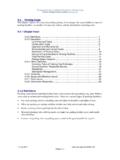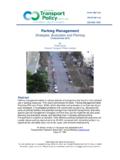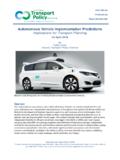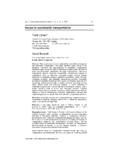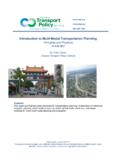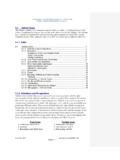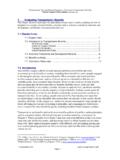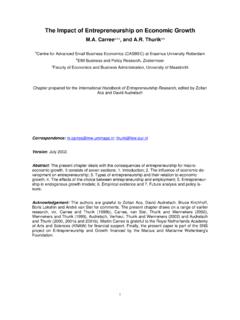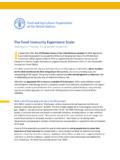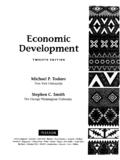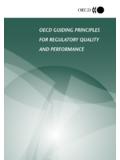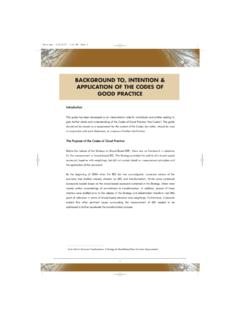Transcription of Transportation Cost and Benefit Analysis - vtpi.org
1 Telephone: 250-360-1560 | email: Todd Litman 1995-2009 You are welcome and encouraged to copy, distribute, share and excerpt this document and its ideas, provided the author is given attribution. Please send your corrections, comments and suggestions for improving it. Transportation cost and Benefit Analysis Techniques, Estimates and Implications Second Edition 2 January 2009 By Todd Alexander Litman Victoria Transport policy Institute With Eric Doherty Abstract This 500+ page document is a comprehensive study of Transportation Benefit and costing, and a guidebook for applying this information. It includes detailed Analysis of various transport costs and benefits . These impacts are described in detail and categorized by various attributes: whether they are internal or external, fixed or variable, market or nonmarket.
2 Using the best available data, it provides monetized estimates of twenty three costs for eleven travel modes under three travel conditions. This document is unique in several important ways. It is one of the most comprehensive studies of its kind, including many often-overlooked impacts. It is the only transport cost study regularly updated as new information becomes available. It explains economic concepts and evaluation techniques. It provides costs values in a format designed to help users easily apply this information to policy Analysis and planning situations. It includes a spreadsheet that automates cost Analysis . It discusses the implications and applications of Analysis results. It provides extensive references, many available through the Internet, so users can obtain more detailed information as needed. This study indicates that on average about a third of automobile costs are external and about a quarter are internal but fixed.
3 Fuel efficient and alternative fuel vehicles tend to have somewhat lower external costs. Transit tends to have lower total costs under urban-peak conditions. Ridesharing tends to have the lowest marginal costs. Motorcycles tend to have relatively high costs due to their high crash risk. Nonmotorized modes (walking and cycling) have minimal external costs. This study describes various policy and planning reforms that can help increase economic efficiency and equity. Transportation cost and Benefit Analysis II Introduction Victoria Transport policy Institute ( ) 2 January 2009 Page 1-1 Chapter Index Introduction .. 2 Guidebook 3 Why Measure Transportation Impacts? .. 4 Improved Vocabulary for Discussing Impacts.
4 4 policy and Planning Evaluation .. 4 Optimal Pricing .. 4 TDM Evaluation .. 4 Equity Evaluation .. 4 Economic Development Impacts .. 5 Defining Traffic, Mobility and Accessibility .. 5 Defining cost .. 6 Internal, External and Social Costs .. 7 Variable or Fixed Costs .. 8 Market or Non-Market Costs .. 9 Perceived or Actual Costs .. 9 Price .. 9 Direct or Indirect Costs .. 9 Economic Transfers, Resource Costs and Taxes .. 10 Summary .. 11 Discount Rate in cost Analysis .. 12 Variability and Uncertainty .. 12 Conservative cost Estimates .. 13 Information Resources .. 15 Notes: 1. Unless stated otherwise, costs in this guidebook are in 2007 dollars and measured in units (mile, foot, US gallons). cost and units in summaries of studies are mainly in the original form used in the studies. Conversions have been done by first converting other currencies to US dollars in the base year and then adjusting for inflation by Consumer Price Index (CPI), based on data at Other inflation adjustment methods may provide different 2.
5 This report is available at The Transportation cost Analyzer spreadsheet is available at 3. This guide is updated regularly. Users should check for possible revisions if working with a version that is more than 12 months old. 1 Lawrence H. Officer (2008), Exchange Rates Between the United States Dollar and Forty-one Currencies, MeasuringWorth ( ); at ; Lawrence H. Officer (2008), The Annual Consumer Price Index for the United States, 1774-2007, MeasuringWorth ( ); at 2 Samuel H. Williamson (2008), Six Ways to Compute the Relative Value of a Dollar Amount, 1790 to Present, MeasuringWorth ( ); at Transportation cost and Benefit Analysis II Introduction Victoria Transport policy Institute ( ) 2 January 2009 Page 1-2 Introduction This chapter describes this guidebook s context and scope, discusses the value of measuring transport impacts, and discusses concepts of transport and cost .
6 Smart consumers investigate all costs and benefits before making major purchase decisions. Prior to buying a car you want accurate information on its fuel, maintenance, repair and insurance costs. Similarly, before buying a train or airline ticket you want to know about all fees and taxes, and the ease of schedule changes. You also want information on each option s reliability, comfort and safety. Just as consumers need accurate and comprehensive information when making personal travel decisions, communities need accurate and comprehensive information on all significant impacts when making transport policy and planning decisions. Most people have limited knowledge of transport economics. They would say, I just want to be able to travel conveniently, safely and affordably, without higher taxes, pollution or conflict with other road users.
7 Notice the just in this statement, reflecting the assumption that these aspirations are modest and reasonable. Yet, they are actually expensive, complex and contradictory. Accommodating ever-growing motor vehicle travel requires significant resources to continually expand roadway and parking capacity, and provide traffic services, in addition to accident risk, pollution emissions and other undesirable impacts. A motorist thinks, I pay vehicle taxes and fees so I should get parking and traffic services, little realizing that their user charges are insufficient to cover the full costs imposed by their driving. Transportation policy and planning decisions affect virtually every aspect of life. Such decisions often involve tradeoffs between conflicting objectives. For example, strategies to increase vehicle travel speeds can increase crash risk and degrade walking conditions.
8 Some emission reduction strategies increase vehicle costs or reduce total motor vehicle travel. Expanding parking supply increases building costs and taxes. This report provides a framework for evaluating and rationalizing such decisions. Some transport impacts, such as vehicle operation costs and travel time values, have been widely studied and estimates of their magnitude are easily available, making them relatively easy to evaluate. Other impacts, such as changes in walking conditions and greenhouse gas emissions, are more difficult to quantify, and so are often dismissed by decision-makers as intangibles, with the implication that they are less important than tangible impacts. The result is decision-making biased in favor of easy-to-measure impacts at the expense of more-difficult-to-measure impacts. This guidebook is intended to support more comprehensive transport policy and planning Analysis by providing Benefit and cost information in a format that is convenient and flexible for evaluating a wide range of options.
9 Transportation cost and Benefit Analysis II Introduction Victoria Transport policy Institute ( ) 2 January 2009 Page 1-3 Guidebook Scope This guidebook provides detailed information on Transportation economic impacts ( benefits and costs). It examines how benefits and costs vary for different travel modes and conditions. It primarily considers personal land transport, plus some information on freight and air transport. It includes data from North America, Europe, Australia, New Zealand, Japan, and other parts of the world. This document is regularly updated as new information becomes available. This guide uses the best available data to develop estimates of the full costs and benefits of various forms of transport, including those that are commonly recognized and some that are often overlooked.
10 It provides an Analysis framework which includes estimates of costs per vehicle-mile or passenger-mile for eleven passenger travel modes under three travel conditions (urban-peak, urban off-peak and rural). The active Transportation health benefits of walking and cycling are also included. These values can be used to estimate the incremental benefits or costs that result from transport changes, such as faster, safer or more affordable travel options. This Analysis framework helps compare and evaluate Transportation activities and planning options. Transportation cost / Benefit Categories 1. Vehicle Ownership 7. Healthful Activity 13. Traffic Services 19. Barrier Effect 2. Vehicle Operation 8. Internal Parking 14. Transport Diversity Value 20. Land Use Impacts 3. Operating Subsidies 9. External Parking 15. Air Pollution 21.

